A vast landscape unfolds within a tiny pot.
Such is the realm of bonsai.
A single tree, rising quietly in its vessel, takes on the presence of an ancient tree deep in the mountains.
Its moss-covered roots anchor it firmly to the earth, carrying the breath of nature within, standing still and strong.
It seems to exist beyond the flow of time itself.
But this presence is no accident.
It is the result of a craftsman’s careful hand and a philosophy honed through deep communion with nature. 。
Bonsai is, in every sense, a living art.
In that confined space, one can feel the flow of wind, the passing of seasons, and the quiet weight of time.
To reflect the grandeur of nature in such a small world—
That is the depth of bonsai, and its greatest allure.
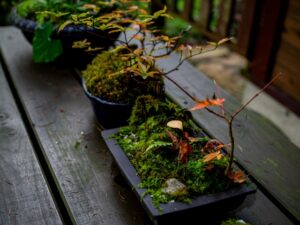
The ability to reflect a natural landscape within a small pot is what makes bonsai so captivating.
The History of Bonsai
Bonsai finds its roots in China, in a tradition called penjing—
a culture of portraying mountains, trees, and streams within pots, recreating nature in miniature.
It is said to have reached Japan in the Heian period,
an age that treasured the beauty of nature and the rhythm of the seasons.
As noble culture flourished in Kyoto, gardens were built with ponds and artificial hills, reflecting an idealized nature that was part of cultured living.
From these roots, the desire to bring nature even closer—into one’s immediate space—gave rise to the art of crafting landscapes in pots.
In the Muromachi period, bonsai grew deeply intertwined with Zen.
It became not merely something to gaze upon, but a vessel for contemplation,
a means to calm the mind and cultivate the spirit.
Zen monks would tend a tree, shape its branches, nurture its moss,
and through this silent act, reflect upon their inner selves.
No sound, no words—just stillness, and the flow of time shared with nature.
With this backdrop, bonsai techniques advanced—
methods of pruning and caring that still form its foundation today.
Bonsai’s Philosophy – An Art that Reflects Time
At first glance, it may resemble a decorative plant—
but bonsai is something far deeper.
While houseplants are meant to be “grown and enjoyed,”
bonsai is “nurtured, shaped, and allowed to evolve with time.”
Each branch is guided, each curve of the trunk shaped with intent,
moss carefully placed at the base—
crafting within the pot a reflection of the natural world.
Here, wild beauty and human will resonate,
and from that quiet harmony, a silent landscape is born.
And yet, that landscape is never complete.
It shifts, it breathes with the seasons,
and continues its journey alongside the one who tends it.
Bonsai carries within it the beauty of the unfinished.
Precisely because it is never done, it holds a boundless allure.
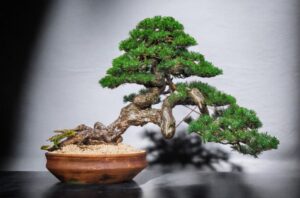
A bonsai is never truly complete. What resides within it is the beauty of the unfinished.
Through the daily rituals of care, we learn patience, accept change, and come to cherish the gentle flow of time.
To face a bonsai is to face oneself.
To release frustration, embrace change, and accept all that is.
Perhaps this is the quiet wisdom bonsai offers us.
Endless Landscapes in a Small Pot
Each bonsai holds its own personality.
Though similar in form, no two are alike—each reveals a different face, each a unique beauty.
Pines and junipers, with rugged trunks and majestic forms, symbolize strength and long life.
Their figures, shaped over decades, exude a quiet resilience.
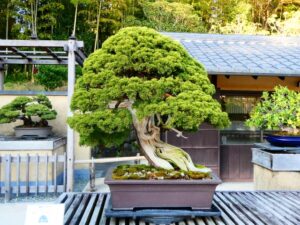
The dignified form of the shinpaku (Japanese juniper) symbolizes strength and longevity.
In contrast, flowering and fruiting trees— cherry, plum, persimmon, crabapple— bring seasonal delight.
Spring blossoms, autumn foliage, ripening fruit—
they whisper of changing seasons and the weight of passing years.
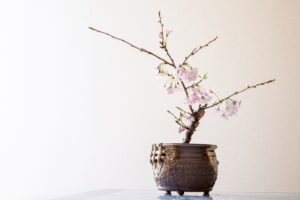
The cherry blossom bonsai invites us to savor the passing of the seasons.
Bonsai also takes many shapes:
The straight trunk reaching skyward (chokkan) holds quiet nobility.
The wind-blown form (shakan) suggests softness and grace.
The cascading branches of kengai evoke the drama of cliffside landscapes.
The slender, poetic lines of the bunjin-gi style offer quiet simplicity.
Each form, each tree, reflects nature’s boundless variety—
a vast world, gently born within a tiny pot.
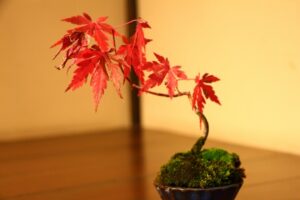
Within the confined space of the pot, one can sense the flow of wind, the shifting seasons, and even the weight of accumulated time.
A Boundless World in a Palm-sized Vessel.
As seasons pass and years layer one upon another, the tree ages alongside the hands that care for it.
On days when things don’t go as planned—
even those shifting forms are accepted as they are.
No haste, no impatience—
only a quiet attention to the living world before you.
Bonsai speaks to us across time, a silent, enduring art.




コメント